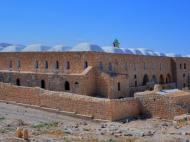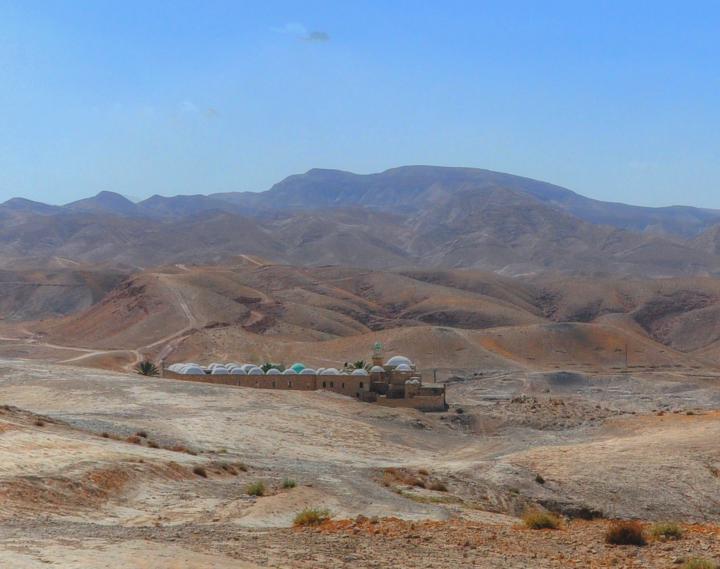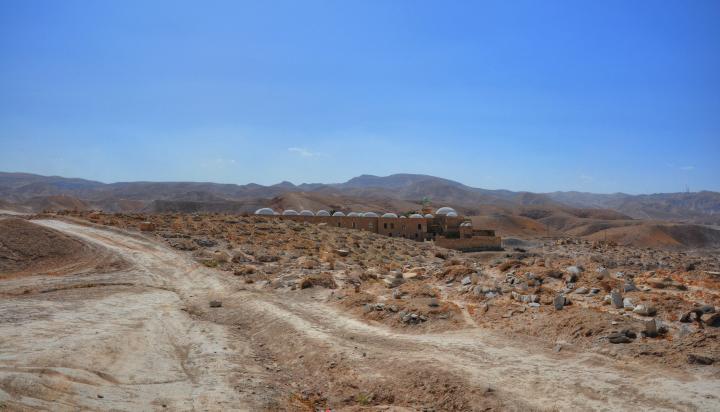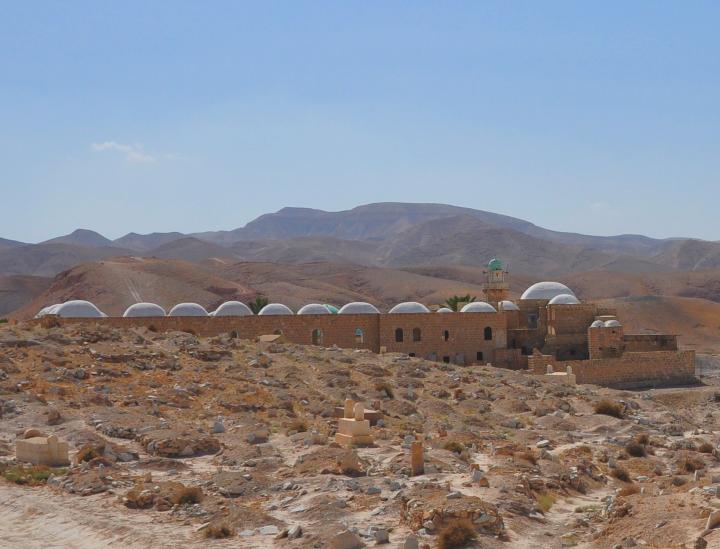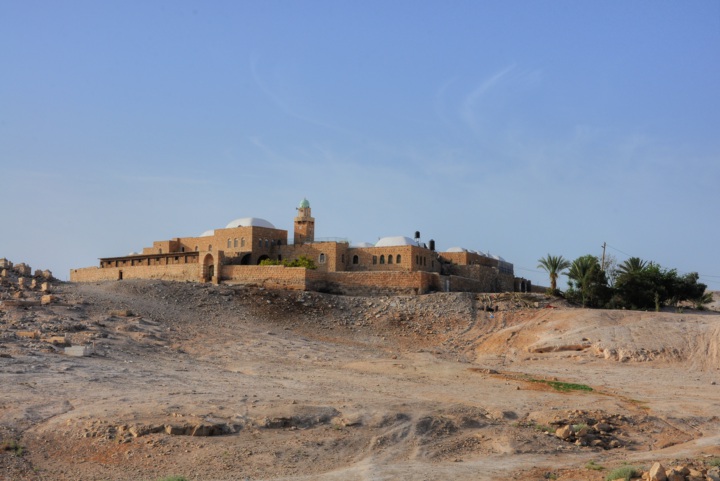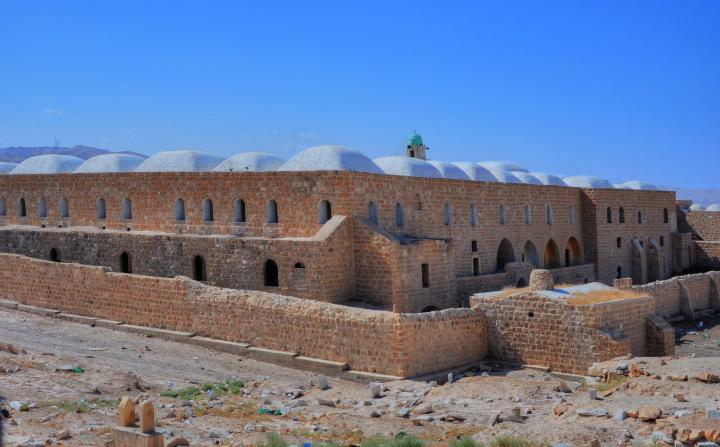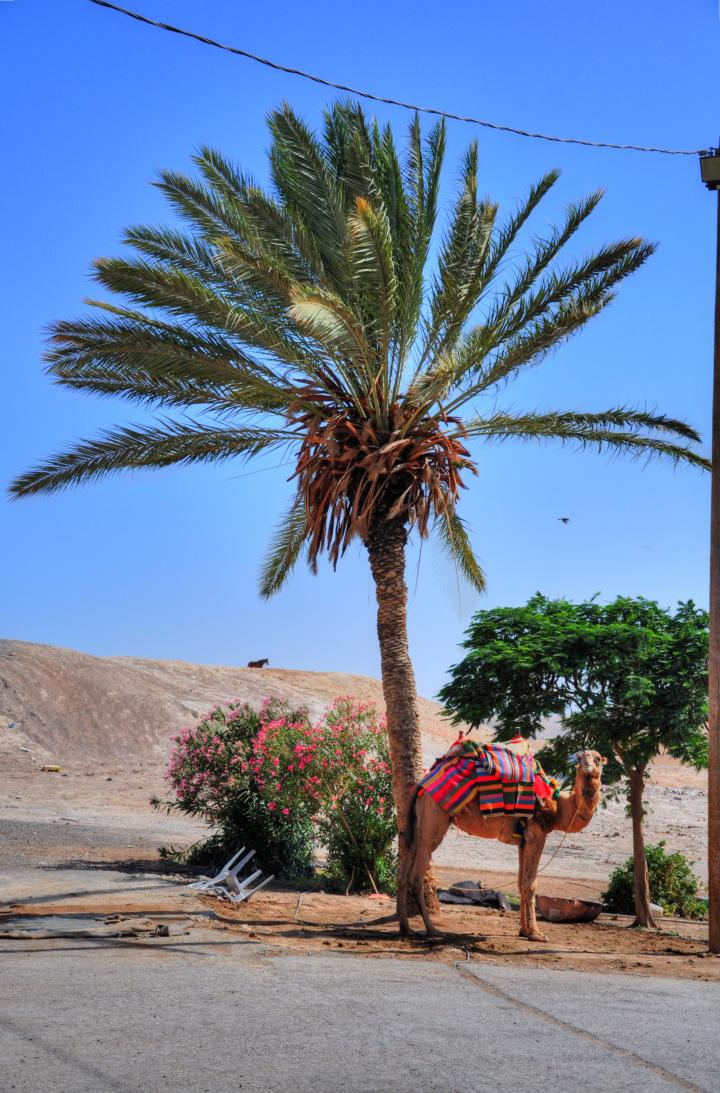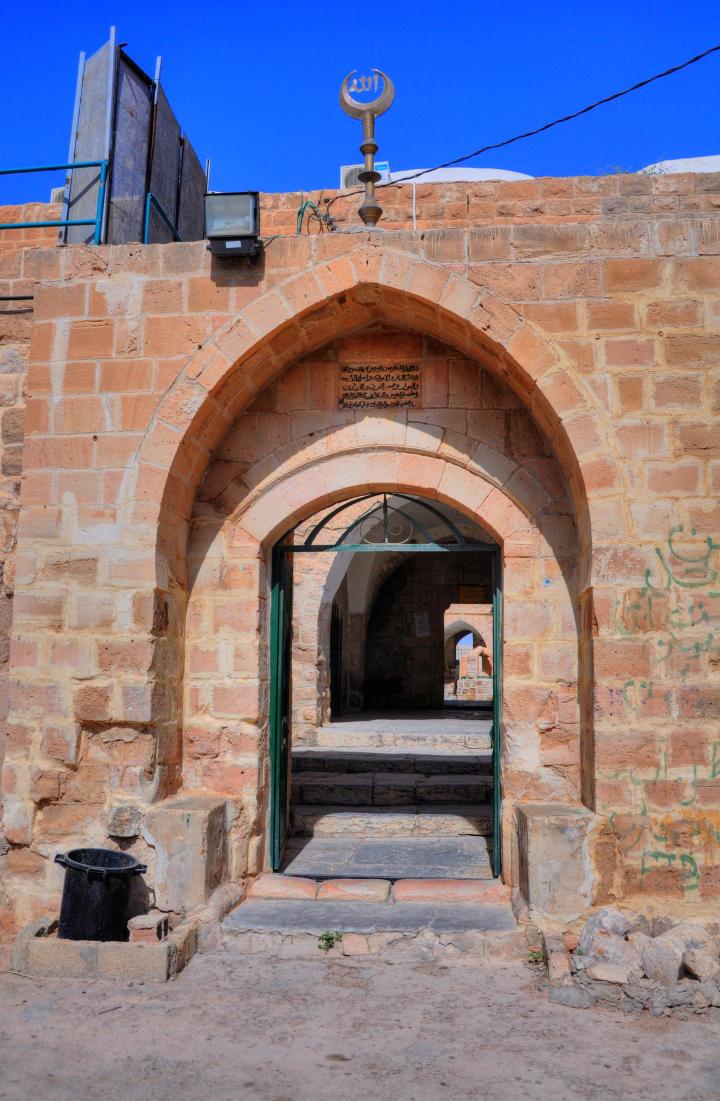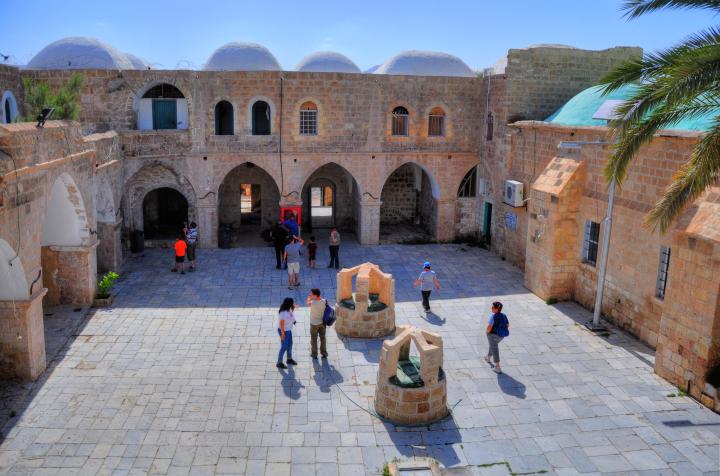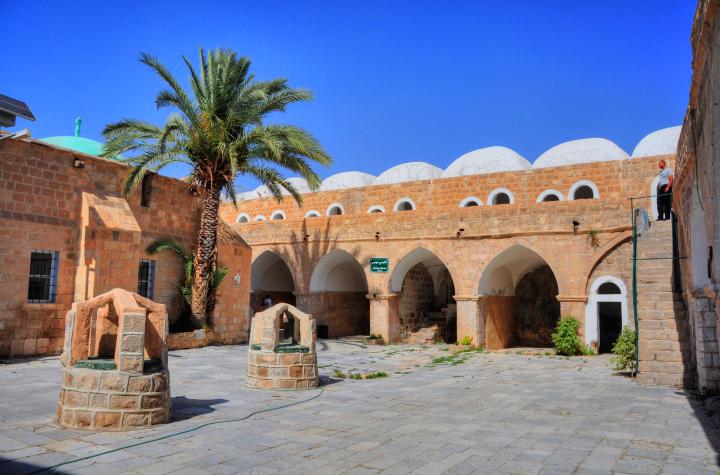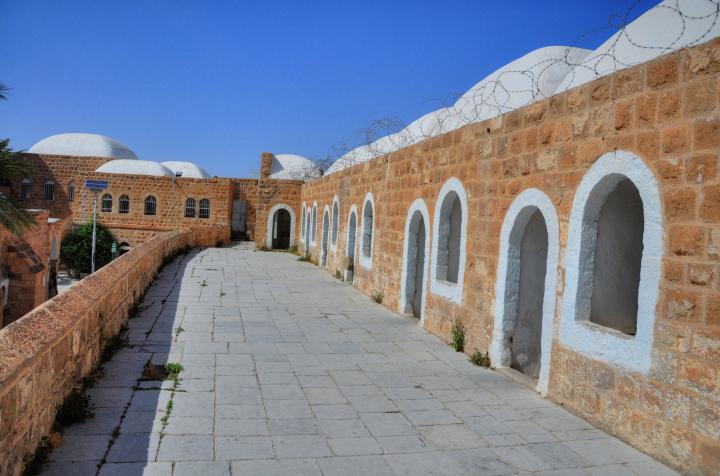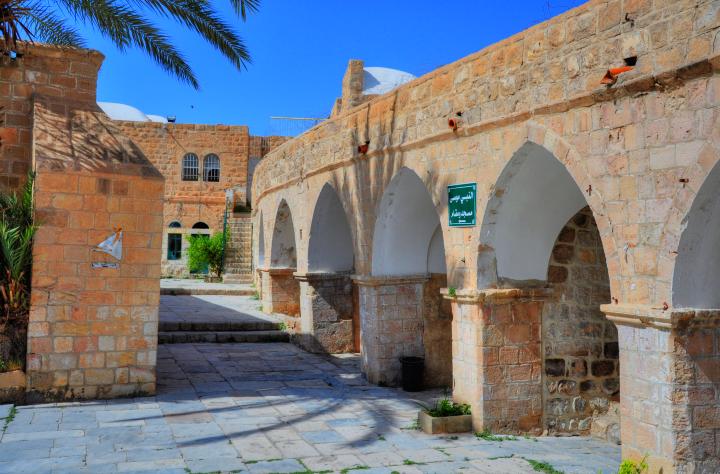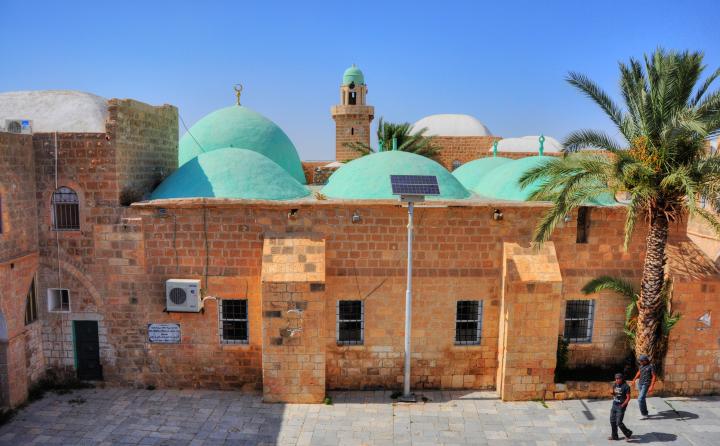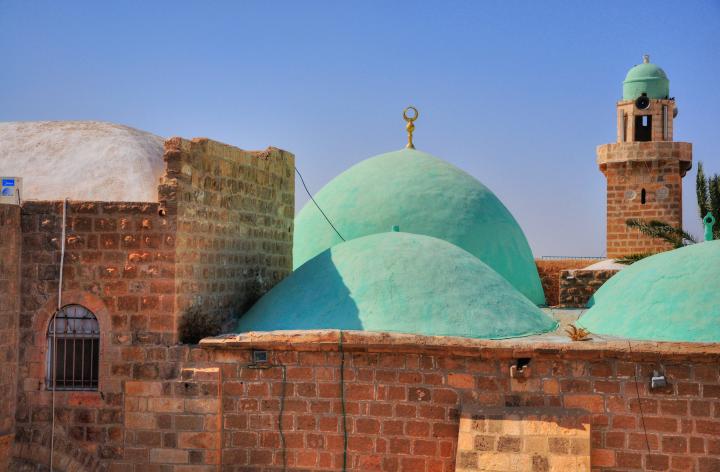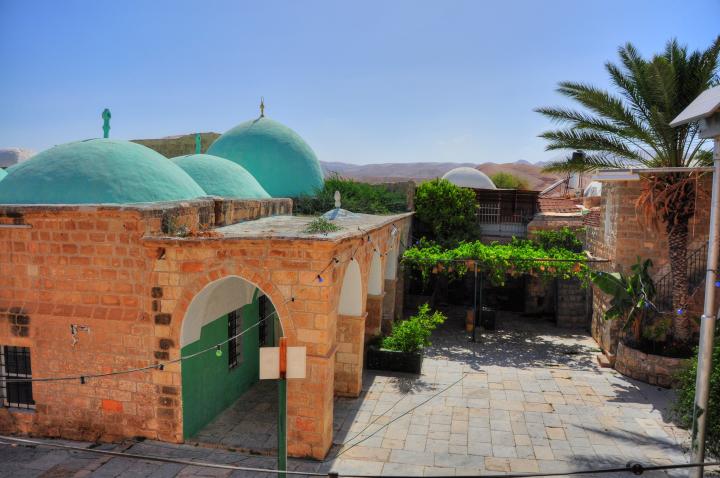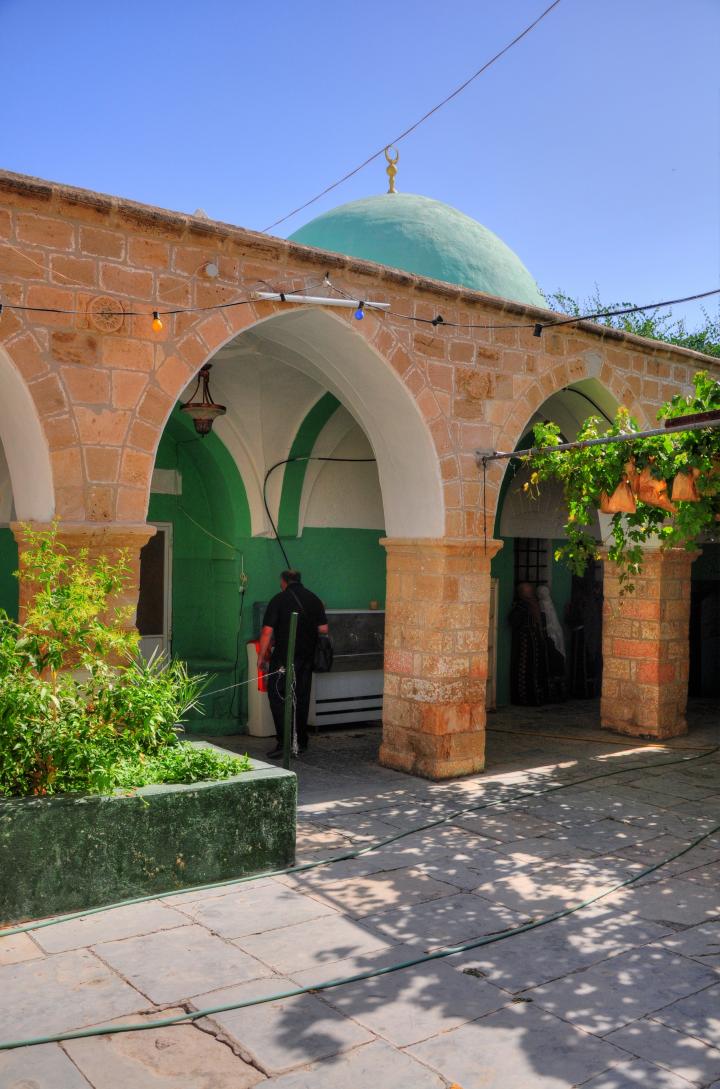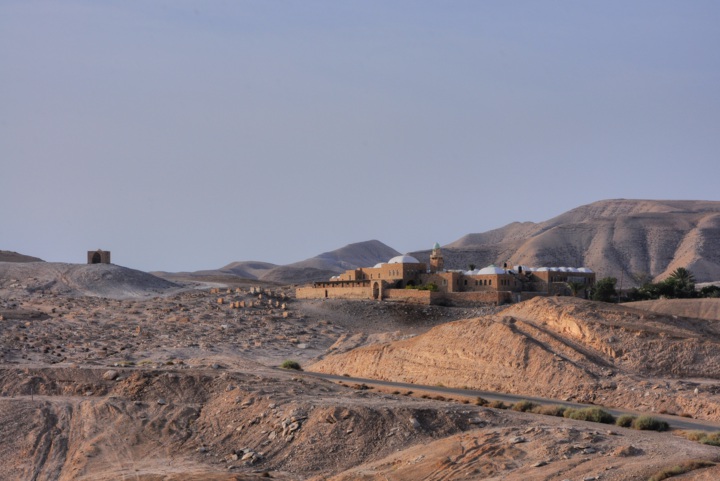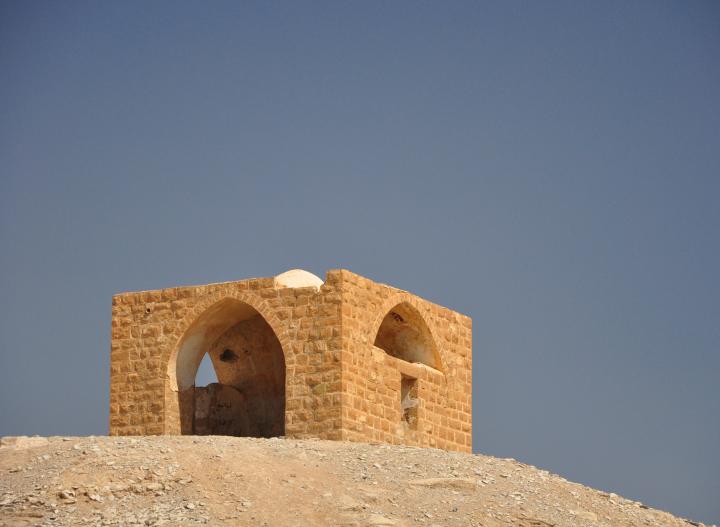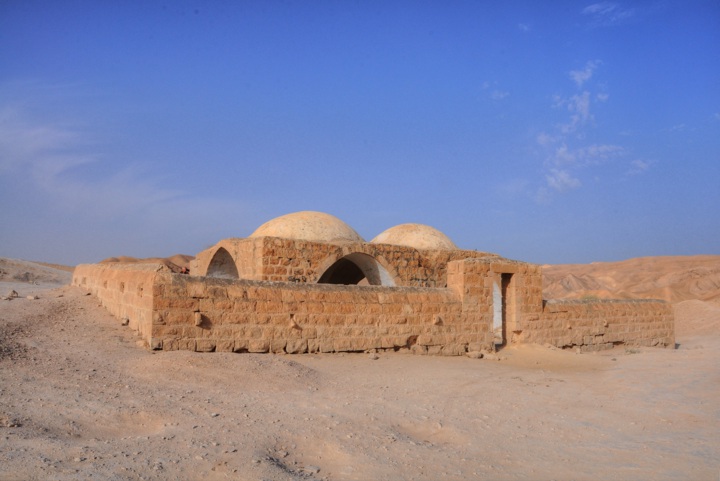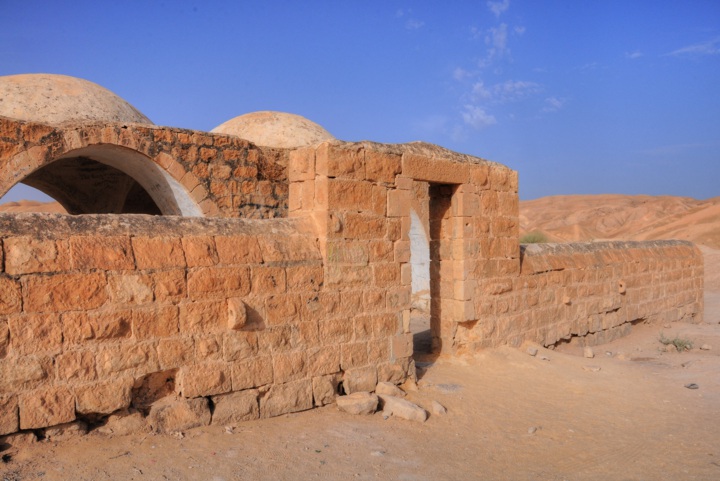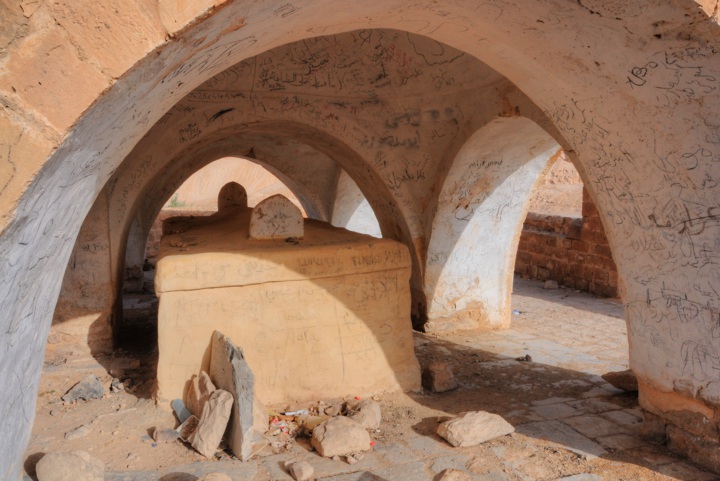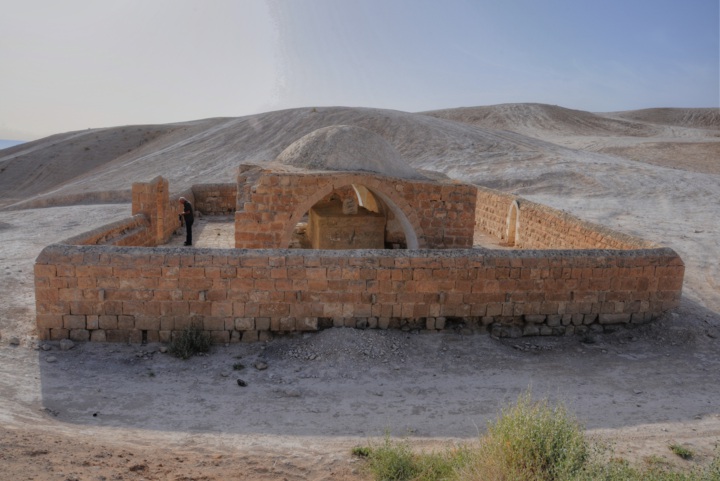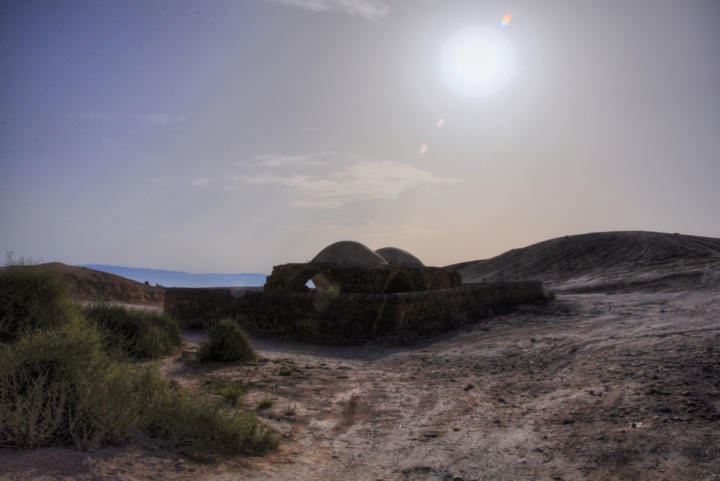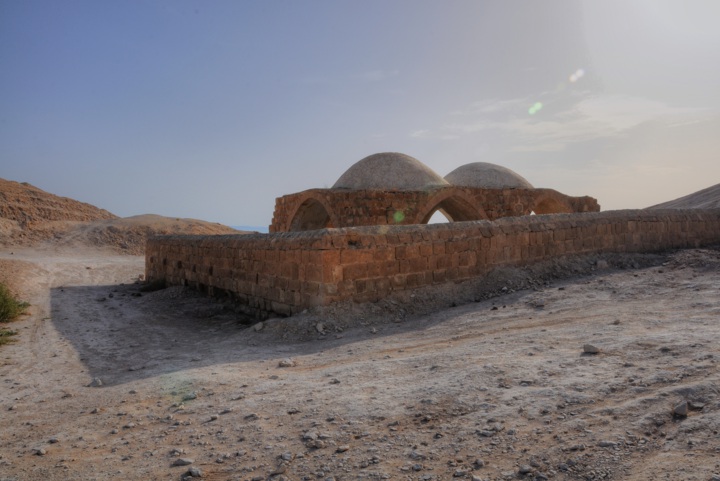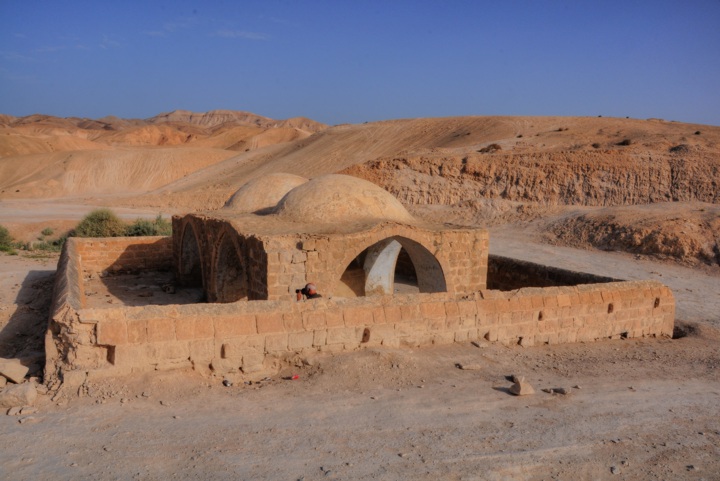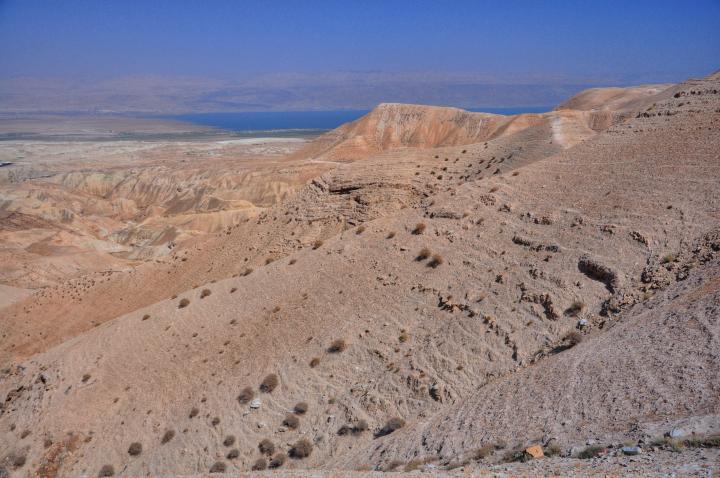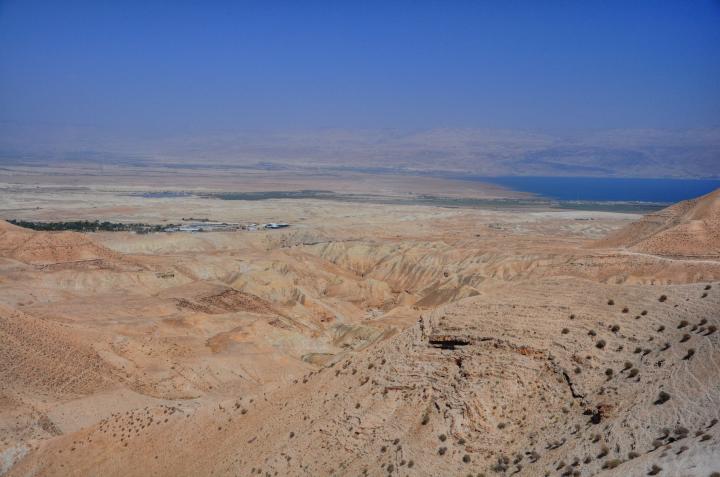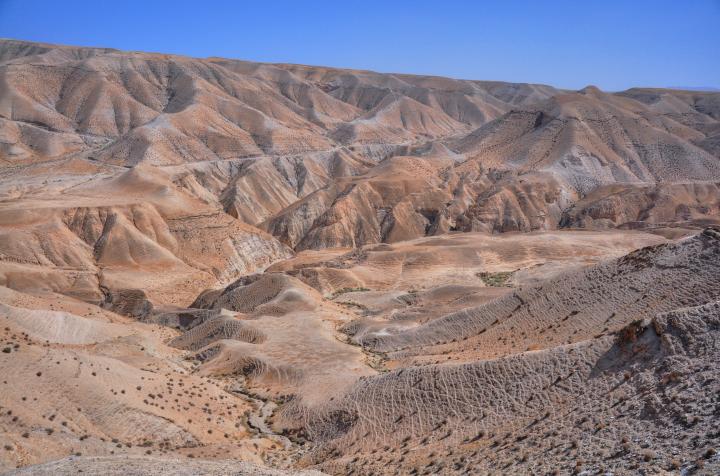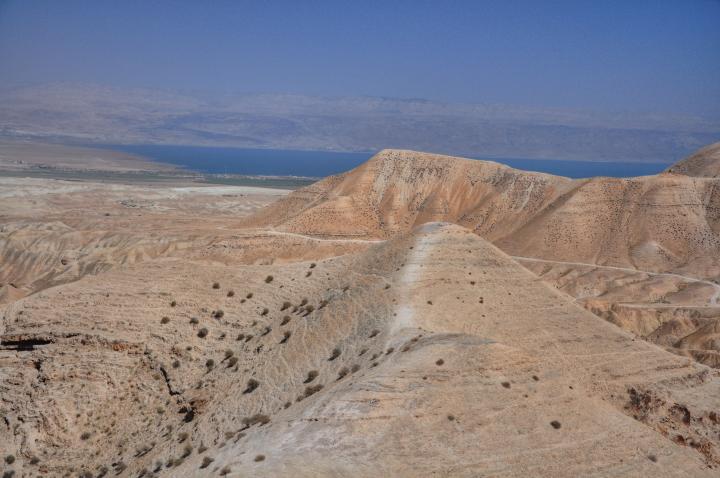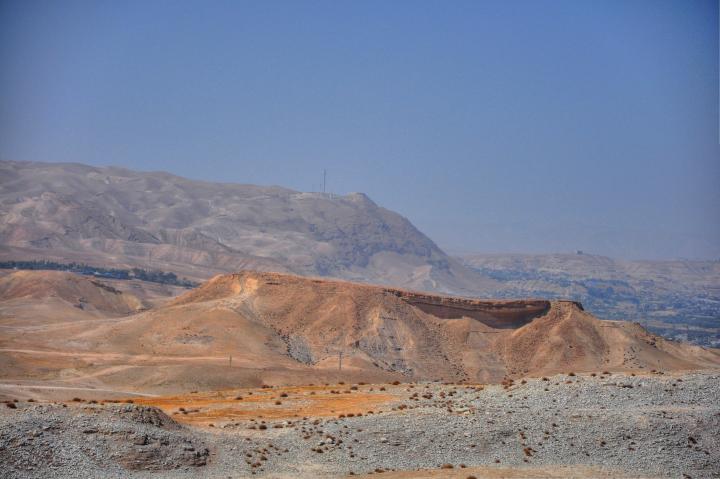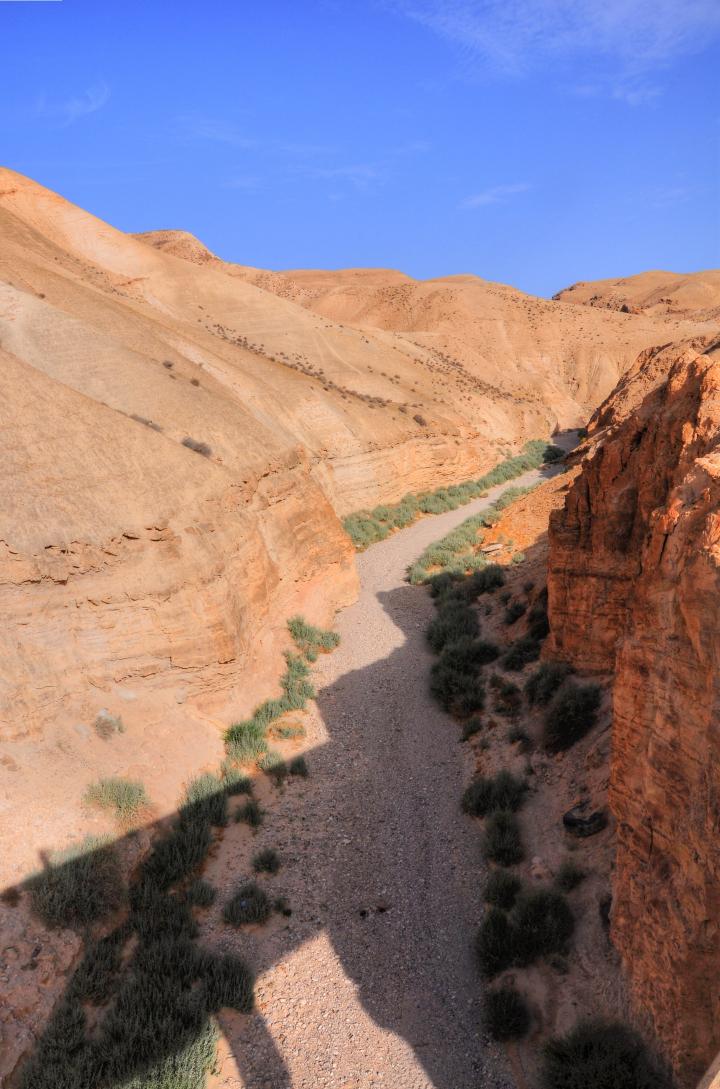An ancient Holy Muslim site located on the side of the road from Jerusalem to Jericho, built in the 13th century and dedicated to Prophet Moses (Nebi Musa).
Home > Sites > Judea > Nebi Musa (Neby Musa, Nabi Musa)
Contents:
Background
Location
History
Photos
* General
* Exterior
* Courtyard
* Center
* Sitna
* Makam Hassan er Ra’ai
* Observation
* Og
Etymology
Links
Overview:
An ancient Holy Muslim site located on the side of the road from Jerusalem to Jericho. It is dedicated to Prophet Moses (Nebi Musa or Nabi Musa), which according to Muslim tradition is buried here near the red hill. This large walled complex includes 120 rooms, a large number of white capes above its roofs, and a high tower. A large cemetery is located in the fields around the complex. The annual of Nebi Musa festival attracted thousands of believers every year since it was constructed in 1270 by the Mamluke Sultan Baybars.
Location and Aerial map:
The site is located on the east side of a red hill, on the north side of the Valley of Horkania, 75m below sea level. A road connects the place to Highway #1 (Jerusalem to Jericho), which is 1.5 Km to the north. Jericho is located 8KM north-east.
The aerial map below is oriented with the north on the left side, in order to show the orientation with Mt Nebo (which is the Jewish and Christian tradition of the place where Moses died and was buried by God).
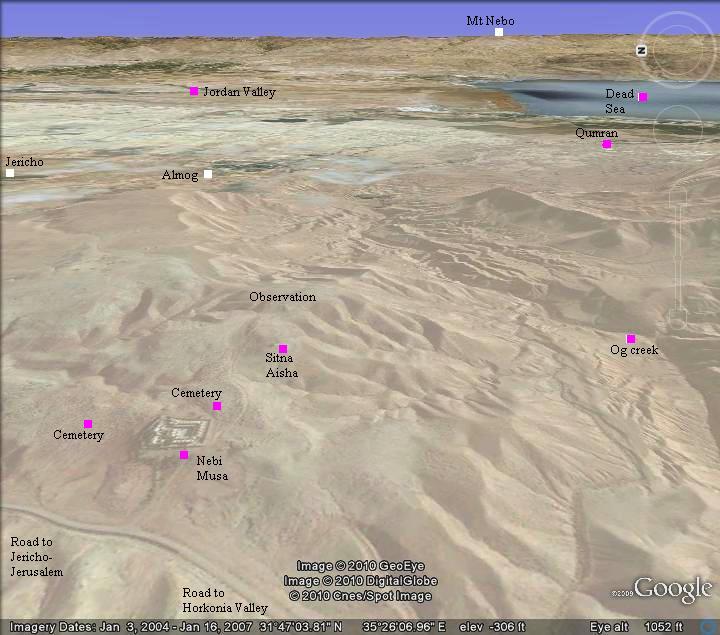
History of the place:
- Prehistoric times
An ancient road passes Nebi Musa on the south side along the Og Creek, descending from Jerusalem to the Dead Sea. The red hill of Nebi Musa was a landmark on this road, and probably a Holy site due to the ancient tombs located around it, dated to the Chalcolithic period.
- Biblical period
During the Bronze and Iron age periods, a west-east road passed north of Nebi Musa. David Dorsey (“The roads and Highways of Ancient Israel”, 2018, p. 204-205) marked this road as ‘J32’, using the same route as the modern highway #1. It passed north of Nebi Musa, descending to Jericho and the Jordan river crossing at the Makhadet Hajlah ford. Another road (‘J32c’) branched from the Jerusalem-Jericho road, passing southeast near Nebi Musa to the plain of Jericho. A cluster of Iron Age sites at the bottom of the descent indicated the use of this route during the Old Testament period.
- Moses
According to the Bible, Moses died before entering to the Holy Land. His unknown tomb is located, according to Jewish and Christian traditions, somewhere on or around Mt Nebo, which is located across the Jordan valley on the hills of present Jordan.
The Bible describes the last days of Moses (Deuteronomy 34 1-6):
“And Moses went up from the plains of Moab unto the mountain of Nebo, to the top of Pisgah, that is over against Jericho. And the LORD showed him all the land of Gilead, unto Dan, And all Naphtali, and the land of Ephraim, and Manasseh, and all the land of Judah, unto the utmost sea, And the south, and the plain of the valley of Jericho, the city of palm trees, unto Zoar. And the LORD said unto him, This is the land which I sware unto Abraham, unto Isaac, and unto Jacob, saying, I will give it unto thy seed: I have caused thee to see it with thine eyes, but thou shalt not go over thither. So Moses the servant of the LORD died there in the land of Moab, according to the word of the LORD. And he buried him in a valley in the land of Moab, over against Bethpeor: but no man knoweth of his sepulchre unto this day”.
There are several traditions that located the tomb of Moses to several sites on the eastern side of the Jordan river. Nebi Musa is an exception, since it is located on the western side.
- Mameluke period
According to the inscription in Nebi Musa, the original structure of a mosque was constructed by the Sultan Baybars in 1270AD. It was dedicated to Prophet Moses (Nebi Musa), which is one of the most holiest figures in the Quran besides Mohammed. The choice of this particular location for marking the tomb of Moses is not clear, and clearly contradicts the Biblical description. This choice of location may have been a military decision (to protect the road to Jerusalem), or may have been selected since it was a holy burial site during earlier times.
Over the years Nebi Musa was expanded, protected by walls, and includes 120 rooms in its two levels which hosted the visitors. A large open cemetery is located around the complex.
-
Ottoman period
The sanctuary was restored and expanded in 1885, creating a total area of 5,000 square meters enclosed by a limestone wall.
A section of the PEF SWP map shows the area around Nebi Musa. Two major roads pass near the site (marked by double dashed line) –
- The pilgrim road on the north side, connecting Jerusalem to Jericho. Nebi Musa was a station along this route.
- The Sugar trail along Og creek (Wadi el Kueiserah) connecting Horkonia valley to Dead Sea used to export the sugar from Jericho
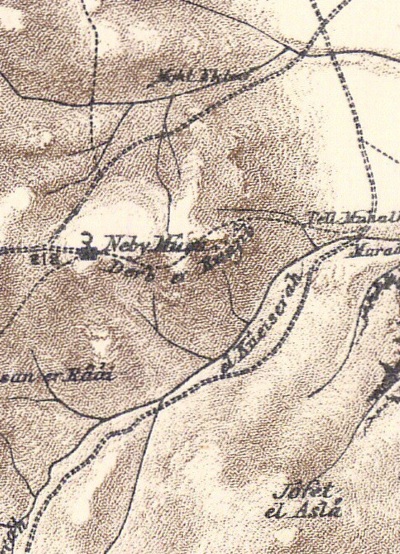
Part of map sheet 18 of Survey of Western Palestine,
by Conder and Kitchener, 1872-1877.
(Published 1880, reprinted by LifeintheHolyLand.com)
- British Mandate period
In February 1918 the British forces (New Zealand unit) fought the Turkish army who used the place as a fortress and positioned five cannons that shelled the open valley, effectively blocking the advance of the British to the east. In order to overcome the Turkish guns, a unit used the Qumran creek (5KM to the south) to penetrate the enemy’s lines by a night operation – descending from Horkonia valley down to the Dead Sea, going along its shore, then walking up the Og creek (Wadi Kaneiterah), and finally capturing the guns of Nebi Musa to remove the blockade.
During the middle ages the site attracted thousands of pilgrims during the annual festival of Nebi Musa in the Spring time. These festivals were intended to counter balance the Easter and Passover pilgrimage to Jerusalem. In the 20th century the gatherings turned political, and sparked riots against the Jewish population (riots of April 1920). The festivals were banned since 1948 by the Jordanians to prevent further unrest.
- Modern times
The site is in Israel since 1967, and is easily approached from Highway #1 (Jerusalem to Jordan valley). The place is open to the public, so a short visit to the place and the observation point on the east of Nebi Musa is a nice detour on the way.
Photos:
(a) General view
Nebi Musa is located on the east side of a red hill on the north side of the valley of Horkonia, north-west of the Dead Sea. The photo shows the walled complex of the sanctuary from the east side. Jerusalem is way behind the mountains, and the whole area is a dry desert.
Click on the photos to view in higher resolution…
Around Nebi Musa, mainly on its east and north side, is a large Muslim cemetery.
A closer view of Nebi Musa, from the east side:
Additional photo of Nebi Musa is seen here, taken from the north.
(b) Exterior
The sanctuary of Nebi Musa, with its 120 rooms, is surrounded by walls from all sides. Above the 2 story structure are many white capes (can you count them?).
Along the entrance road are food stands, and a camel that has parked here by the palm tree.
The main entrance to the court is located on the west side.
(c) Courtyard
The entrance opens to a courtyard. Around the yard are rooms on two floors, and the mosque on the right side.
In the center are two wells which supplied water to the pilgrims.
A view of the second floor, with rooms that hosted the visitors, is in the next picture. When we visited the site (May 2010) the rooms were undergoing repairs and cleaning.
The following photo shows a view of the eastern side of the yard, where the steps lead around to the entrance to the mosque.
(d) Mosque in the center
In the center of the yard, under the green painted capes, is the mosque.
The minaret (call to prayers tower) is seen behind it.
The room in the center is the oldest section in the sanctuary, built by the Mameluke Sultan Baybars in 1227.
Inside the room is a monument covered by a green cloth which marks the place of the tomb of Moses – according to the Muslims.
(e) Sitna Aisha
On the south-east side of Nebi Musa, seen on its left side below, is a single caped tomb named Sitna Aisha – “our Lady Aisha”. She was the 3rd wife of Mohammed the founder of the Muslim faith.
A closer view of the tomb:
(f) Tomb of Hasa er Ra’ai
Several hundred meters south of Nebi Musa, on the side of the road, is the Makam Hassan er Ra’ai. The name means – place of prayer (Makam) dedicated to the Shepherd (Ra’ai) named Hassan.
The entrances to the structure is on the north and south sides:
This Makam is actually a tomb. It is not known who is buried here, but the name identifies it as the tomb of Hassan. According to Muslim tradition, he was the shepherd of Jethro (father in law of Moses).
Additional photos of this charming structure are shown below.
(f) Observation
About 1KM to the east of Nebi Musa, on the edge of the cliff, is a good place for an observation place of the cliffs of the Syrian-African depression – the deepest place on earth . The drop of these cliffs is from -66m (the height of this point) to -418m (the Dead Sea).
The northern side of the Dead Sea is seen on the far left side. Beyond it are the Jordanian mountains, including Mt Nebo which is exactly on the other side of Nebi Musa. The settlement on the left side is Almog, a kibbutz established in 1979 on the basis of a Nahal Army base.
The Og creek (Wadi Mukelik in the upper section, Wadi Kaneiterah in the lower section) passes on the south side of Nebi Musa.
A view of the northern edge of the Og creek, in direction of the Dead Sea and Qumran, is below. This was the Biblical border of the tribe of Judah, which indicates the ascent of Adummim as its north-east border (Joshua 15 1-7): “This then was the lot of the tribe of the children of Judah by their families… And the east border was the salt sea, even unto the end of Jordan. And their border in the north quarter was from the bay of the sea at the uttermost part of Jordan: And the border went up to … Adummim, which is on the south side of the river…”.
A view towards Jericho (on the right side) is seen below. The tall hill in the center on the horizon is the location of the fortress of Qipros, one of the seven desert fortresses built by Herod the Great in order to protect the eastern borders of his kingdom.
(g) Og creek
The path of the Og creek (Wadi Kaneiterah) is a favorite route for bikers, who ride down to the Dead Sea. This is also the path of the ancient road (called “sugar road”) that connected the north of the Dead Sea to Horkania fortress and up to Jerusalem. Along this route are remains of Iron Age fortifications.
A bridge over Og is located south of Nebi Musa. This picture was taken from that bridge.
Etymology (behind the name):
* Names of the site:
- Nebi Musa – Arabic: Nebi=prophet, Musa – Moses. Also spelled: Nabi, Neby.
- Sitna Aisha – A tomb south-east of Nebi Musa. Arabic – Our Lady Aisha – Mohammed’s 3rd wife.
- Sugar Trail – ancient road from Horkonia valley to Dead Sea. This route was used to export the sugar from Jericho
* Names of Adumim:
- Ma’ale Adummim – Hebrew: Red Ascent or Red Heights. This is the area above Nebi Musa, named after the red hills. In Biblical times it was a landmark the north-east border of Judah (Joshua 15 7): “before the going up to Adummim…”. Ma’ale Adumim is also the name of the city on the eastern suburbs of Jerusalem, which was established in 1991, and named after the Biblical place.
- Mishor Adummim – Hebrew: Mishor is “plains”. The name of the industrial zone in Ma’ale Adummim, and a settlement established in 1975.
Links:
* External:
- Battles of NZ unit in WW1 – Neby Musa campaign
- Bike Hike via Nebi Musa – video of a desert ride from Mishor Adumim to Almog
* Internal:
- Horkania – nearby Hasmonean and Byzantine site
BibleWalks.com – Moses did not make it to the Holy Land – but you can!…
Secacah <<<—previous site—<<< All Sites >>>—next Judea site—>>>Desert Water
This page was last updated on Aug 29, 2024 (add PEF Map)
Sponsored links:
